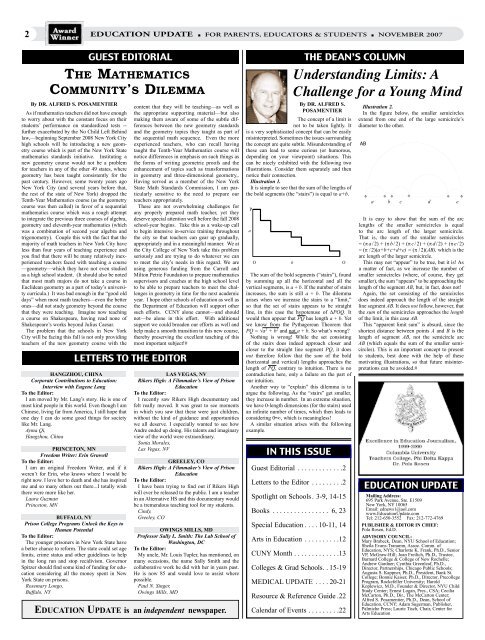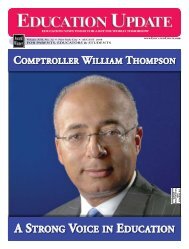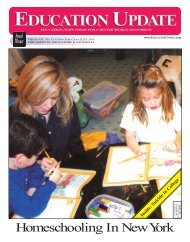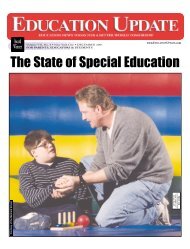Download PDF - Education Update
Download PDF - Education Update
Download PDF - Education Update
You also want an ePaper? Increase the reach of your titles
YUMPU automatically turns print PDFs into web optimized ePapers that Google loves.
<strong>Education</strong> update ■ For Parents, Educators & Students ■ NOVEMBER 2007by Dr. Alfred S. PosamentierAs if mathematics teachers did not have enoughto worry about with the constant focus on theirstudents’ performance on standardized tests --further exacerbated by the No Child Left Behindlaw,—beginning September 2008 New York Cityhigh schools will be introducing a new geometrycourse which is part of the New York Statemathematics standards initiative. Instituting anew geometry course would not be a problemfor teachers in any of the other 49 states, wheregeometry has been taught consistently for thepast century. However, some twenty years agoNew York City (and several years before that,the rest of the state of New York) dropped theTenth-Year Mathematics course (as the geometrycourse was then called) in favor of a sequentialmathematics course which was a rough attemptto integrate the previous three courses of algebra,geometry and eleventh-year mathematics (whichwas a combination of second year algebra andtrigonometry). Couple this with the fact that themajority of math teachers in New York City haveless than four years of teaching experience andyou find that there will be many relatively inexperiencedteachers faced with teaching a course—geometry—which they have not even studiedas a high school student. (It should also be notedthat most math majors do not take a course inEuclidean geometry as a part of today’s universitycurricula.) It was bad enough in the “good olddays” when most math teachers—even the betterones—did not study geometry beyond the coursethat they were teaching. Imagine now teachinga course on Shakespeare, having read none ofShakespeare’s works beyond Julius Caesar.The problem that the schools in New YorkCity will be facing this fall is not only providingteachers of the new geometry course with theHangzhou, ChinaCorporate Contributions to <strong>Education</strong>:Interview with Eugene LangTo the Editor:I am moved by Mr. Lang’s story. He is one ofmost kind people in this world. Even though I amChinese, living far from America, I still hope thatone day I can do some good things for societylike Mr. Lang.Ayma Qi,Hangzhou, ChinaPrinceton, MNFreedom Writer: Erin GruwellTo the Editor:I am an original Freedom Writer, and if itweren’t for Erin, who knows where I would beright now. I love her to death and she has inspiredme and so many others out there...I totally wishthere were more like her.Laura GuzmanPrinceton, MNBuffalo, NYPrison College Programs Unlock the Keys toHuman PotentialTo the Editor:The younger prisoners in New York State havea better chance to reform. The state could set agelimits, crime status and other guidelines to helpin the long run and stop recidivism. GovernorSpitzer should find some kind of funding for educationconsidering all the money spent in NewYork State on prisons.Rosemary Longo,Buffalo, NYGUEST EDITORIALThe MathematicsCommunity’s DilemmaLETTERS TO THE EDITORcontent that they will be teaching—as well asthe appropriate supporting material—but alsomaking them aware of some of the subtle differencesbetween the new geometry standardsand the geometry topics they taught as part ofthe sequential math sequence. Even the moreexperienced teachers, who can recall havingtaught the Tenth-Year Mathematics course willnotice differences in emphasis on such things asthe forms of writing geometric proofs and theenhancement of topics such as transformationsin geometry and three-dimensional geometry,.Having served as a member of the New YorkState Math Standards Commission, Illustration I am par-1.the concept are quite subtle. Misunderstanding of ABUnderstanding these can lead Limits: to some A curious Challenge (or humorous, for a Young Minddepending on your viewpoint) situations. ThisThe concept of a limit can is be not nicely to be taken exhibited lightly. It with is a very the sophisticated following concept two that can be easilymisinterpreted. Sometimes the issues surrounding concept are quite subtle. Misunderstanding of theseillustrations. Consider them separately and thencan lead to some curious (or humorous, depending on your viewpoint) situations. This can be nicelyexhibited with the notice following their two illustrations. connection. Consider them separately and then notice their connection.Illustration 1.It is simple to see that the sum of the lengths ofticularly sensitive to the need to prepare It is simple our to see that the the bold sum segments of the lengths (the of “stairs”) the bold segments is equal (the to “stairs”) a + b. is equal to a+b.teachers appropriately.a b c d eThese are not overwhelming challenges forPany properly prepared math teacher, yet theydeserve special attention well before the fall 2008It is easy to show that the It sum is of easy the arc to lengths show of that the smaller the sum semicircles of the is arc equal to the aschool-year begins. Take this as a wake-up calllarger semicircle. That lengths is, the sum of of the smaller semicirclesis equalto begin intensive in-service training throughout a a b c d to e the arc length of = + + + + =the larger semicircle.( a + b + c + d + e) = ( AB), which is the arc length of thethe city so that teachers can gear up gradually,2 2 2 2 That 2 2is, the sum of the 2 smaller semicirclesappropriately and in a meaningful manner. We atThis may not “appear” to = ( be a true, / 2) but + ( it is! b / 2) As + a ( matter c / 2) of + fact, ( d as / 2) we + increase ( e / 2) the numberthe City College of New York take this problemsemicircles (where, of course, = ( / 2)(a+b+c+d+e) they get smaller), the = ( sum / 2)(AB), “appears” which to be is approaching the the lseriously and are trying to do whatever we cansegment AB, but, in fact, arc does length not! of the larger semicircle.to meet the city’s needs in this regard. We are O b Q This may not “appear” to be true, but it is! Asusing generous funding from the Carroll andAgain, the set consistingaofmatterthe semicirclesof fact,doesas weindeedincreaseapproachthethenumberlength ofofthe straightLas Vegas, NVRikers High: A Filmmaker’s View of Prison<strong>Education</strong>To the Editor:I recently saw Rikers High documentary andfelt really moved. It was great to see momentsin which you saw that these were just children,without the kind of guidance and opportunitieswe all deserve. I especially wanted to see howAndre ended up doing. His talents and imaginaryview of the world were extraordinary.Sonia Morales,Las Vegas, NVGreeley, CORikers High: A Filmmaker’s View of Prison<strong>Education</strong>To the Editor:I have been trying to find out if Rikers Highwill ever be released to the public. I am a teacherin an Alternative HS and this documentary wouldbe a tremendous teaching tool for my students.Cindy,Greeley, COOwings Mills, MDProfessor Sally L. Smith: The Lab School ofWashington, DCTo the Editor:My uncle, Mr. Louis Tupler, has mentioned, onmany occasions, the name Sally Smith and thecollaborative work he did with her in years past.He is now 85 and would love to assist wherepossible.Paul N. Singer,Owings Mills, MD<strong>Education</strong> <strong>Update</strong> is an independent newspaper.The DEAN’S COLUMNUnderstanding Limits: AChallenge for a Young MindBy Dr. Alfred S.Illustration 2.PosamentierA similar situation arises with the following example.In the figure below, the smaller semicirclesThe concept Illustration of a limit 2. In is the figure extend below, from the one smaller end semicircles of the large extend semicircle’sfrom one end of the largnot to be diameter taken lightly. to the other. It diameter to the other.is a very sophisticated concept that can be easilymisinterpreted. Sometimes the issues surroundingMilton Petrie Foundation to prepare mathematicsThe sum of the bold segments The sum (“stairs”), of the bold found segments by summing It(“stairs”), all does the not horizontal follow,found and however, all smaller the vertical that thesemicircles segments, sum of the semicircles approaches the length of the lim(where, of course, they getis a + b . If the number of stairs increases, the sum is still aAB.+ b . The dilemma arises when we increase thesupervisors and coaches at the high school level by summing up all the horizontal and all the smaller), the sum “appears” to be approaching thestairs to a “limit,” so that the set of stairs appears to be straight line, in this case the hypotenuse of POQ . Itto be able to prepare teachers to meet the challengesin geometry in time for the next academic increases, the sum is still a + segment b. The AB, dilemma not the semicircle Again, arc the AB (which set consisting equals the of sum the of the semicircles smaller semicircles).vertical segments, is a + b. If the number of stairs length of the segment AB, but, in fact, does not!would then appear that PQ has length a + b . Yet we know This from “apparent the Pythagorean limit sum” Theorem is absurd, that since the shortest distance between points A and B is t2 2year. I hope other schools of education PQas = well a + as b and arises not a + when b . So what’s we increase wrong? the stairs important to a concept “limit,” to present does to indeed students, approach best done the with length the help of of the these straight motivating illustrthe Department of <strong>Education</strong> will support other so that the set of stairs appears future to misinterpretations be straight line can segment be avoided. AB. It does not follow, however, thatsuch efforts. CCNY alone cannot—and Nothing should is wrong! line, While in the this set consisting case the of the hypotenuse stairs does indeed of ∆POQ. approach It closer the and sum closer of to thesemicircles approaches the lengthstraight line segment PQ, it does not therefore follow that the sum of the bold (horizontal and vertical)not—be alone in this effort. With additional would then appear that PQ has length a + b. Yet of the limit, in this case AB.support we could broaden our effortslengthsas wellapproachesand wethe lengthknowoffromPQ , contrarythe Pythagoreanto intuition. ThereTheoremis no contradictionthathere,Thisonly“apparenta failure onlimit sum” is absurd, since thehelp make a smooth transition to this newthe partcourse,of intuition.PQ = √a 2 + b 2 and not a + b. So what’s wrong? shortest distance between points A and B is thethereby preserving the excellent teachingAnotherofwaythisto “explain”Nothingthis dilemmais wrong!is to argueWhilethe following.the setAsconsistingthe “stairs” getlengthsmaller, theyof segmentincrease inAB, not the semicircle arcmost important subject!#number. In an extreme of the situation, stairs we does have 0-length indeed dimensions approach (for closer the stairs) and used an AB infinite (which number equals of the sum of the smaller semicircles).This is an important concept to presenttimes, which then leads closer to considering to the straight 0i , which line is segment meaningless! PQ, it doesnot therefore follow that the sum of the bold to students, best done with the help of these(horizontal and vertical) lengths approaches the motivating illustrations, so that future misinterpretationscan be avoided.#length of PQ, contrary to intuition. There is nocontradiction here, only a failure on the part ofour intuition.Another way to “explain” this dilemma is toargue the following. As the “stairs” get smaller,they increase in number. In an extreme situation,we have 0-length dimensions (for the stairs) usedan infinite number of times, which then leads toconsidering 0•∞, which is meaningless!A similar situation arises with the followingexample.In This IssueGuest Editorial . . . . . . . . . . . . .2Letters to the Editor . . . . . . . . .2Spotlight on Schools . 3-9, 14-15Books . . . . . . . . . . . . . . . . 6, 23Special <strong>Education</strong> . . . . 10-11, 14Arts in <strong>Education</strong> . . . . . . . . . .12CUNY Month . . . . . . . . . . . . .13Colleges & Grad Schools . . 15-19MEDICAL UPDATE . . . . 20-21Resource & Reference Guide. 22Calendar of Events . . . . . . . . .22EDUCATION UPDATEMailing Address:695 Park Avenue, Ste. E1509New York, NY 10065Email: ednews1@aol.comwww.<strong>Education</strong><strong>Update</strong>.comTel: 212-650-3552 Fax: 212-772-4769PUBLISHER & EDITOR IN CHIEF:Pola Rosen, Ed.D.ADVISORY COUNCIL:Mary Brabeck, Dean, NYU School of <strong>Education</strong>;Sheila Evans-Tranumn, Assoc. Comm. of<strong>Education</strong>, NYS; Charlotte K. Frank, Ph.D., SeniorVP, McGraw-Hill; Joan Freilich, Ph.D., Trustee,Barnard College & College of New Rochelle;Andrew Gardner; Cynthia Greenleaf, Ph.D.,Director, Partnerships, Chicago Public Schools;Augusta S. Kappner, Ph.D., President, Bank St.College; Bonnie Kaiser, Ph.D., Director, PrecollegeProgram, Rockefeller University; HaroldKoplewicz, M.D., Founder & Director, NYU ChildStudy Center; Ernest Logan, Pres., CSA; CeciliaMcCarton, Ph.D., Dir., The McCarton Center;Alfred S. Posamentier, Ph.D., Dean, School of<strong>Education</strong>, CCNY; Adam Sugerman, Publisher,Palmiche Press; Laurie Tisch, Chair, Center forArts <strong>Education</strong>
















